
Yucca brevifolia is a plant species belonging to the genus Yucca. It is tree-like in habit, which is reflected in its common names.
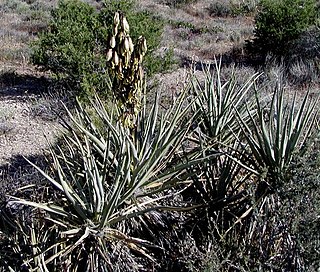
Yucca baccata is a common species of yucca native to the deserts of the southwestern United States and northwestern Mexico, from southeastern California north to Utah, east to western Texas and south to Sonora and Chihuahua. It is also reported in the wild in Colombia.
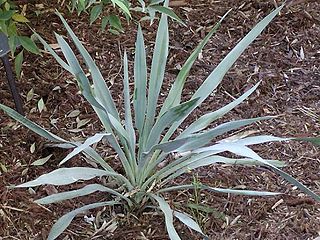
Yucca pallida, sometimes called pale yucca, is a species of yucca native to Northern Mexico and parts of the blackland prairies of northern and central Texas, and notable for its light-colored leaves that range from a pale blue-gray to sage-green in color.

Yucca schidigera, also known as the Mojave yucca or Spanish dagger, is a flowering plant native to the southwest deserts of North America.

Yucca elata is a perennial plant, with common names that include soaptree, soaptree yucca, soapweed, and palmella. It is native to southwestern North America, in the Sonoran Desert and Chihuahuan Desert in the United States, southern Nevada, southwestern Utah, and northern Mexico. Yucca elata is widely distributed, although its population appears to be decreasing.

Hesperoyucca is a small genus of two recognized species of flowering plants closely related to, and recently split from, Yucca, which is in the century plant subfamily within the asparagus family.

Yucca gloriosa is a species of flowering plant in the family Asparagaceae, native to the southeastern United States. Growing to 2.5 m (8 ft), it is an evergreen shrub. It is widely cultivated as an ornamental for its architectural qualities, and has reportedly become established in warmer climates in the wild in various parts of the world.

Yucca × schottii is a plant species in the genus Yucca, native to southern Arizona, southwestern New Mexico, and the northern parts of Sonora and Chihuahua. The common names are Schott's yucca, hoary yucca, and mountain yucca. The "×" in the name indicates that this is a nothospecies, regarded as being a natural hybrid between two other species. In this case, Yucca × schottii is believed to have originated as a hybrid between Y. baccata and Y. madrensis. Yucca × schottii is firmly established and does reproduce freely in the wild.

Yucca declinata is a species of the genus Yucca, family Asparagaceae. It is known only from the vicinity of Bacanora, in the Mexican state of Sonora. Botanist Howard Scott Gentry first collected the species and mentioned it in print, noting the differences between this population and the closely related species Y. grandiflora H. S. Gentry and Y. arizonica McKelvey. He did not, however, describe it as a new species. Later examination of his descriptions and his material led to the recognition of this as a new species.

Yucca arkansana, the Arkansas yucca, is a plant in the family Asparagaceae, native to Texas, Oklahoma, Arkansas, Missouri and Kansas. It generally grows in gravelly, sunlit locations such as rocky outcrops, prairies, etc. It is not considered to be threatened.

Yucca angustissima, the narrowleaf yucca, is a plant in the family Agavaceae, known as the "narrow-leaved yucca." It is native to Arizona, New Mexico, Colorado and Utah, but grown elsewhere as an ornamental.
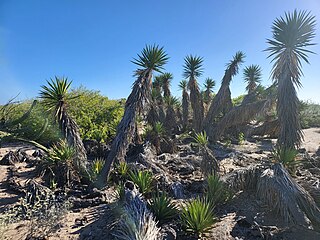
Yucca valida is a plant species in the family Asparagaceae, native to the Mexican states of Baja California, Baja California Sur, Sonora, and Sinaloa. The common name is datilillo.

Yucca lacandonica is a plant species in the yucca genus with the common name "tropical yucca." It is native to Belize and to southern Mexico, the states of Chiapas, Veracruz, Tabasco, Quintana Roo, Campeche, and Yucatán. It is uniquely the only epiphytic species in the genus, although it has been reported to grow terrestrially as well.

Yucca baileyi is a plant in the family Agavaceae. It is native to Utah, Arizona, New Mexico and Colorado but has been cultivated elsewhere. Much of its native range is within the boundaries of the Navajo (Diné) Reservation, hence the common name "Navajo yucca." The Navajo people make extensive use of yucca fibers to make a wide assortment of useful and ceremonial items. They also use the roots as soap. It is not considered to be threatened, as it has a large range and an overall stable population.
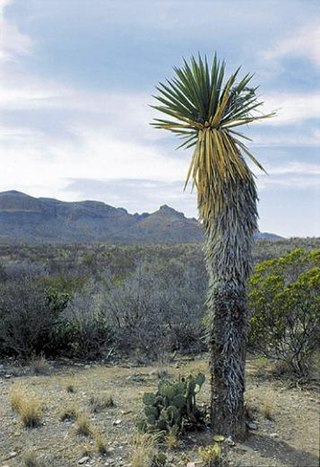
Yucca carnerosana, commonly known as the giant Spanish dagger, is a species of North American plant in the asparagus family that grows in arid and desert climate areas. In the United States, it is confined to only a few counties in western Texas, where endemic populations are found in rocky outcrops. The species is, however, widely distributed in northern Mexico. It has a wide range and is abundant, and although it has local threats, its population appears to be stable overall.

Yucca constricta known by the common name "Buckley's yucca," is a plant in the family Asparagaceae. It is found in rocky limestone hills of central and eastern Texas, and also in Coahuila, Mexico.

Yucca campestris, the plains yucca, is a species in the family Asparagaceae, endemic to the "panhandle" region of northwestern Texas. It is considered to be endangered, mainly due to habitat loss.
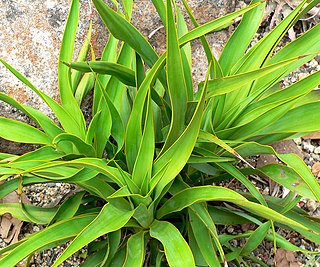
Yucca rupicola is a plant in the family Asparagaceae, known as the twistleaf yucca, twisted-leaf yucca, Texas yucca or twisted-leaf Spanish-dagger. The species was described by George Heinrich Adolf Scheele in 1850. This is a small, acaulescent plant with distinctive twisted leaves. It is native to the Edwards Plateau region of Texas and also to northeastern Mexico.

Yucca intermediaMcKelvey is a species in the family Asparagaceae, with the common name intermediate Yucca. It is a relatively small plant forming clumps of rosettes. It is native to dry steppes, juniper-pinyon woodlands and savannahs, and desert grassland areas of the northwestern quarter of the US State of New Mexico, then into the Four Corners region, at an elevation of 1,400–2,300 m (4,600–7,500 ft).

Yucca treculianaCarrière is a species of flowering plant in the family Asparagaceae, native to Texas, New Mexico and Coahuila. Common names include Spanish dagger, Spanish bayonet and Don Quixote's lance.





















